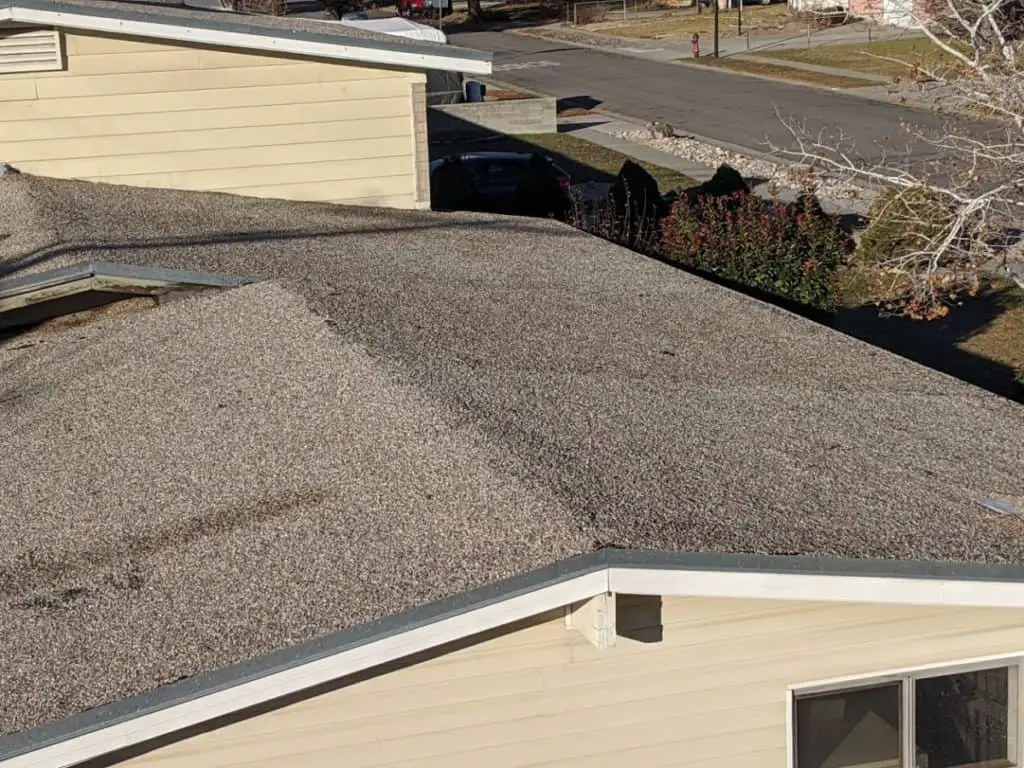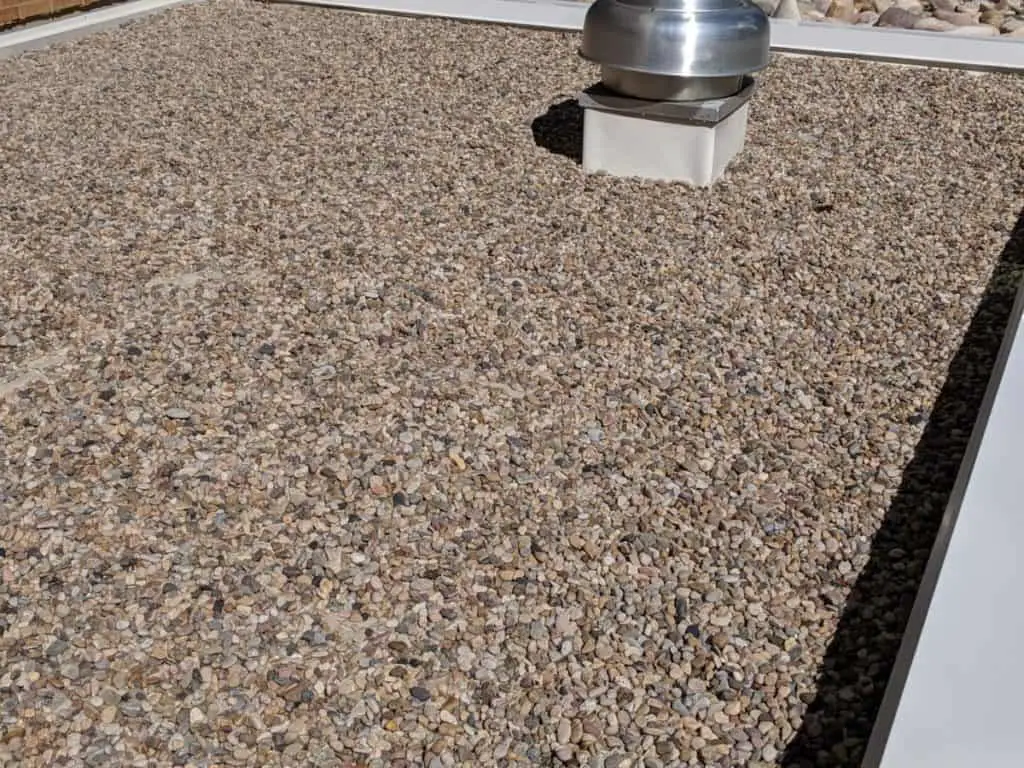
What is Built-Up Roof?
A built-up roof (BUR) also known as a tar and gravel roof is a popular choice for low slope roof owners.
The built-up roof system is made up of multiple layers of various fabric materials. The fabric is layered by alternating a layer of durable fabric with a coat of bitumen (asphalt). Finally, the last layer is topped with rocks or gravel.
Homeowners can choose how many layers they want in their roof system. Each layer will add about 5 years of life to the built-up roof.
Another way of looking at a built-up roof is to imagine that it’s like turning the entire roof into one giant shingle.
Worried About Doing the Work Yourself?
I recommend finding a professional roofing contractor through our trusted partner Home Advisor because they allow you to get up to 4 quotes for free. This allows you to compare and choose the best roofing professional for your needs. Check them out by clicking this link.
Types of Built-Up Roof?
There are two main types of built-up roof systems the Tar & Gravel system and the Ballasted roof system.
The main difference between the two systems has to do with the size of the rocks used.
Tar & Gravel

Tar & Gravel systems use smaller more course rocks. The gravel used is about the size of 0.25″ – 0.5″ inches (0.64 cm -1.27 cm) in diameter.
Another key difference is that on Tar & Gravel roofs, the rocks are sealed down using a bitumen-based chemical.
The bitumen which seals down the gravel can come in two different forms cold applied and heat applied.
The cold applied can be easily spread because it is liquid at standard temperatures but hardens as it cures.
The hot-applied requires a torch to melt the bitumen, then it hardens as it cools.
Ballasted

Ballasted systems use larger rocks. The size of gravel can range anywhere from 1.5″ – 2.5″ inches (3.8 cm – 6.4 cm) in diameter.
The rocks in a ballasted roof system are not sealed, rather they are loosely piled on top of a waterproof membrane.
The waterproof membrane used is not sealed down to the roof but is held in place from the weight of the large stones resting on top of it.
Ballasted roof systems can have anywhere from a few inches of rocks to a foot of rocks.
Pros:
There are many advantages to a built-up roof (BUR) system. Here are just a few of the pros to a built-up roof.

1.Traction:
A built-up roof has great traction for all seasons of the year. The gravel provides excellent grip, especially during snowy cold seasons. This gives a built-up roof system and advantage over other low-slope roof systems like TPO which get very slippery to walk on when covered in snow.
2.Completely Sealed:
Another advantage is that built-up roof systems especially the tar & gravel system is completely sealed. There are no seams that need to be heat-welded or glued down, unlike EPDM. However, this does not apply to all built-up roofs because ballasted roofs require a waterproof membrane that can be made from EPDM, TPO, or PVC.
3.Lifespan:
A built-up roof system can have a worthwhile lifespan. A common rule is that a built-up roof will last about 5 years per layer. This makes it easy to get 20-30 years out of your built-up roof system.
4.Impact Resistant:
Built-up roofs have great impact resistants. The gravel on top makes an excellent shield protecting your roof from hail damage, falling branches, bird pecking, and clam dropping.
5. Doesn’t Depend on the Weather:
The cold applied built-up roof is non-weather dependent. Meaning you can install the cold applied bitumen in colder weather. The cold applied bitumen acts more like glue so it doesn’t need to be heated to secure the gravel.
6.UV resistant:
A built-up roof is highly resistant to UV radiation. The natural rocks act as a perfect barrier to protect the underlayers from the destructive UV rays.
7.Fire Resistant:
Built-up roofs have quite a resistance to fire. Falling ash or sparks will just land on the stone rocks preventing the roof from catching fire.
8.Low Maintenance:
Built-up roofs require very little maintenance. If it does need to be maintained it would be to fix a leak that can happen with any other type of roof system. Or it would be to maybe add some more gravel to the top surface.
9.Easy to Repair:
Built-up roofs are easy to repair. Most repairs will often just involve cutting away membrane layers and replacing it with a new membrane and adding the subsequent layers of bitumen and gravel.
10.Price:
The price for the materials of a Built-Up roof system can cost about $165 to $250 per square. Which can be a pro or a con depending on your budget and if the other pros make it worth the price to you. This price isn’t bad but not great when compared to other roof materials.
Cons:
As with any roof system, there are disadvantages to owning a built-up roof system. Here are some of the cons to a built-up roof.

1.Fading Out:
Built-up roofs are becoming less popular. They are starting to be replaced by other low slope roof systems. With that said there are still cases where a built-up roof may be the best option for your specific circumstances. Consulting with your local roofing advisor to see if a built-up roof is right for you.
2.Wind:
One problem that may occur during strong wind storms is that rocks may get blown off the roof. This could cause damages to other parts of the building or other nearby structures.
3. Finding Leaks:
While it’s fairly simple to repair leaks on a BUR roof, it’s finding the leaks that causes problems. Leaks can be difficult to find on a built-up roof because there are no seams to check. Roofers will have to remove the gravel to see the tar layer underneath. With ballasted roof systems they will have to dig up several inches to feet of gravel to get to the base layer to spot the hole. These make finding leaks a harder, longer, more costly process.
4.Heavy roof:
The tar & gravel roof is not as heavy, but the ballasted roof system can get pretty heavy depending on how much rocks were used. A ballasted roof can weight 10 – 25 lbs per square foot. If you decide on a ballasted roof, you will need to ensure your roof structure can support the weight.
5. Cost/Lifespan is mediocre:
According to the Cost/Lifespan comparison charts, Built-Up roofs are not the most bang for your buck but they are better than other systems. However, these values will vary depending on how many layers are used.
6.Toxic Fumes:
Bitumen when heated produces hazardous fumes. When installing a hot-applied tar & gravel roof, workers are exposed to harmful fumes and must take the necessary precautions to prevent breathing in dangerous gases. This is not the case for cold-applied roof systems or ballasted roof systems.
7.Slower Installation:
Built-up roofs can take a longer time to install than other low slope roof systems. This can add labor costs making the project more expensive for you.
8.Mold:
Where there is moisture there is mold. All types of flat roof systems need to prevent standing water by including drains in the installation process. With a built-up roof system, gravel can clog the drain or trap moisture between the stones making this roof system more vulnerable to mold.
Should I get a Built-Up roof?
There is a reason why built-up roofs still exist today. Its because they are still a viable option. However, I can’t tell you specifically if it is right for you because it all depends. Everyone is different and everyone has different circumstances so there is no easy answer to this question. It’s up to you to do your research and see if the pros outweigh the cons. You can also check out the alternative options for a built-up roof system to see if there is something better suited for your needs.
Alternatives Options:
If a Built-Up Roof doesn’t sound like the right kind of roof for you. There are at least 6 other options available for low slope/flat roofs. Below I have placed a nice little chart with links to other Pros & Cons lists for the other 6 low slope roofing options.
If you are interested in other roofing options I recommend you take a look at this article which I spent several months writing. It is a complete guide where I explain about 17 different types of roofing materials that are used today. You can read the article here.
This chart table shows the 6 other options for low slope roofs.
| Type | Description |
|---|---|
| FleeceBack roof | FleeceBack roof system is a Fleece material made out of polyester that can be added to the underside of EPDM, PVC, or TPO. It is adhered to the surface of the roof using 2-part fast adhesive foam. Click Here to Learn More about the FleeceBack roof system. |
| EPDM | EPDM stands for Ethylene Propylene Diene Terpolymer. It’s a rubber-based material. Click Here to Learn More about EPDM. |
| TPO | TPO stands for Thermoplastic Polyolefin. This is a single-ply flat roof system that the newest of all the flat roof systems. Click Here to Learn More about TPO. |
| Spray-On Roof (SPF) | Spray-On roof has been around since 1964 and involves spraying layers of polyurethane and silicone. Click Here to Learn More about Spray-On Roof. |
| PVC | PVC stands for Polyvinyl Chloride and is made up of ethylene and chlorine which are derived from processed petroleum or natural gas and salt respectively. Click Here to Learn More about PVC. |
| Modified Bitumen | Modified Bitumen is a 2-part flat roof system. It was developed in Europe around the 1960s. It comes in two different types. Click Here to Learn More about Modified Bitumen. |
Related Questions:
What is the best material for a flat roof? It depends on your specific circumstances. The climate, location, roof structure, style preferences, and budget all play a role in deciding which one is best for you. However, TPO is one of the newest flat roof systems that was developed within the last 30 years.
Is a flat roof a good idea? Flat roofs are a great option for commercial buildings or homeowners who like modern style. Flat roofs are energy efficient, which can help you to save you money.
